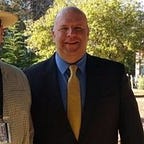Next Generation 9–1–1: Why the 10,000 foot view is no longer appropriate
In 2016, someone took a bold step. Someone decided assigning a date, or more appropriately, a deadline, was necessary to advance the national dialogue on what is considered by many to be the hottest topic in the history of the emergency communications profession. That step, the NG911NOW Coalition, encouraged major players and stakeholders in the 9–1–1 workspace to embrace the year 2020 as the red letter year for nationwide acceptance, readiness, and implementation of NG9–1–1 technology. When I first read about the endeavor, I remember thinking “four years…way too aggressive for the amount of work needing to be done”. But the more I thought about it, the more I felt putting a date on the national effort was the right thing to do. After all, NG9–1–1 had, in concept, been talked about in one capacity or another since the late 90’s, well before the term Next Generation 9–1–1 had been coined. What better way to get people to “stop talking” and “start doing” than to instill the idea of a deadline in the minds of those closest to the effort.
The NG911NOW Coalition announcement occurred in February 2016. With 2020 as a deadline, those charged with promoting and furthering the NG9–1–1 effort at that time had just shy of four years to achieve their goal; a lofty goal indeed. Now, over two years later, and two years closer to the deadline, the goal seems even loftier.
There is no doubting the importance of the team approach relative to bringing the Next Generation 9–1–1 plan to fruition nationwide. Success will be reliant on a number of key players: line level PSAP personnel, national 9–1–1 organizations, industry experts, software developers, hardware manufacturers, and quite certainly, America’s wireless communications providers. Policy and decision makers at the local, state, and federal level will also be crucial in this effort. All of these entities, as well as those who simply share a passion for innovation and progress will be key when it comes to moving the chains on this very important initiative.
Over the course of the last few years, I have attended a number of seminars, watched a variety of webinars, and read countless articles on Next Generation 9–1–1. While some of these presentations offered suggestions as to what the future of emergency communications should look like, the majority were very much “awareness level”, spending far too much time talking about the history of 9–1–1, the need for Next Generation 9–1–1 nationwide (we already know that), and identifying some of the prospective players who will likely play a part in the nationwide NG9–1–1 roll out. In some cases, these “players” were actually sponsoring the sessions. A few made mention of potential problems associated with the arrival of this technology (increased stress, legal ramifications, etc.), but did little in the way of “digging in” to the problems or providing viable solutions. As a result, I have become far more discriminating when it comes to registering for webinars and signing up for informational sessions at conferences. I simply don’t have the time to hear about where were going; what I want to know is what we should be doing when we get there.
In the PSAP I worked for previously, with the Director’s approval, I created a Next Generation 9–1–1 Working Group. This group, made up of telecommunicators, dispatchers, and even our in-house GIS staffer, worked on identifying major issues within the 9–1–1 workspace relative to the roll out of NG9–1–1. Topics included training, the role of the peer facilitator, recruiting & retention, incident related imagery (IRI), and a number of other important subjects. While I didn’t get as far as I would have liked with the group (I left after accepting a position with another PSAP), in the short time we’d worked together, we made considerable progress in a number of different areas. More importantly, as a group of 9–1–1 professionals, we had a consistent dialogue on issues which will absolutely be a top concern and warrant further discussion once the switch for Next Generation 9–1–1 is flipped. What if you did the same thing in your center? What if we all shared the results of our efforts in an open forum? Why shouldn’t the feet on the street, the telecommunicators and dispatchers who do this job every day, share their thoughts and ideas on the potential impact of NG9–1–1 technology on the PSAP?
With FirstNet being nationally adopted, wireless providers touting the availability of 5G before the end of the year, and emergency communications manufacturers boasting the latest and greatest in Next Generation 9–1–1 technology, all 9–1–1 professionals should be concerned about the lack of information available relative to the operational impact of NG9–1–1. Solution providers, subject matter experts, and other key players in the 9–1–1 space need to begin developing and presenting relevant and actionable content which will help emergency communications professionals prepare their centers and personnel for the arrival of these technologies. Presentations, conference calls, and webinars on NG9–1–1 shouldn’t be conducted in the future tense; they should be in the here and now.
As a profession, we need to stop speculating about the impact of Next Generation 9–1–1. We need to be bold. We need to recognize these technologies are already here, and in short order, will be arriving in our PSAP’s. Our personnel need to know and understand that before too long, incident related imagery (IRI) in the form of still images, pre-recorded video, and streaming media will be arriving at their terminals. The dialogue we’re having as administrators and PSAP leadership can’t be confined to our conference rooms. We have to be open and honest with our people about the future of our profession, and where we see it going. Hopefully, industry stakeholders and subject matter experts will take notice and begin developing and presenting content which will help those of us trying to deliver that message.
-DJD
